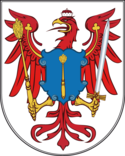Brandenburg-Prussia
Brandenburg-Prussia Brandenburg-Preußen | |||||||||||
|---|---|---|---|---|---|---|---|---|---|---|---|
| 1618–1701 | |||||||||||
| Growth of Brandenburg-Prussia 1600–1795 Growth of Brandenburg-Prussia 1600–1795 | |||||||||||
| Capital | Berlin (Königsberg) | ||||||||||
| Government | Principality | ||||||||||
| Elector-Duke | |||||||||||
• 1618–1619 | John Sigismund | ||||||||||
• 1619–1640 | George William | ||||||||||
• 1640–1688 | Frederick William | ||||||||||
• 1688–1701 | Frederick III | ||||||||||
| Historical era | Holy Roman Empire | ||||||||||
| August 27 1618 | |||||||||||
| September 19, 1657 | |||||||||||
| January 18 1701 | |||||||||||
| |||||||||||
Brandenburg-Prussia (German: Brandenburg-Preußen) was a German monarchy established by the personal union between the Duchy of Prussia and the Margraviate of Brandenburg in 1618.
The monarchy was ruled by the branch of the Hohenzollern dynasty that had earlier ruled Brandenburg. The term Brandenburg-Prussia refers to this monarchy from its establishment until 1701, after which it is usually known as the Kingdom of Prussia. The term "Brandenburg-Prussia" is sometimes used to describe the Brandenburg-led state after the creation of the Kingdom of Prussia in 1701, but this state is known simply as "Prussia" after 1806.
History
The Duchy of Prussia was created through the secularization of the Prussian lands of the Teutonic Knights. It was a vassal of Poland and was governed by a cadet branch of the House of Hohenzollern. After the death of Duke Albert of Prussia in 1568, the duchy passed to the feeble-minded Albert Frederick. Because of the duke's sickness, Prussia was governed by the regents George Frederick, Margrave of Brandenburg-Ansbach (1577–1603) and Joachim Frederick, Elector of Brandenburg (1603–1618).
Albert Frederick's daughter Anna married Joachim Frederick's son John Sigismund, and the main Hohenzollern branch in Berlin was granted the right of succession to the duchy. The Electors of Brandenburg inherited the Duchy of Prussia upon Albert Frederick's death in 1618, but the duchy continued to be held as a fief under the Polish Crown until 1657.
During the reign of the ineffective George William (1619–1640), the Hohenzollern lands were repeatedly invaded by various armies in the Thirty Years' War. During much of the war, Sweden occupied substantial territory in Brandenburg-Prussia. Taking advantage of the difficult position of Poland against Sweden during the Northern Wars, George William's successor Frederick William obtained full sovereignty for Brandenburg over Prussia from King Władysław IV Vasa of Poland in the Treaty of Wehlau in 1657. The rights of the Polish Crown meant the duchy would legally revert back to Poland if the Hohenzollern dynastic line became extinct; this clause, which was to be renewed at each country's change of ruler, expired by 1700.
The location of the Duchy of Prussia outside the Holy Roman Empire—within which no ruler could call himself king—allowed Elector Frederick III of Brandenburg to become "king in Prussia" in 1701, in return for assisting Emperor Leopold I in the War of the Spanish Succession. This severed all links to Poland, and the first Prussian king was the last ruler of Brandenburg-Prussia who spoke fluent Polish. In 1773 the former duchy was reorganized into the province of East Prussia, while most of the Polish province of Royal Prussia became West Prussia. In 1806, Brandenburg, from which the kingdom was ruled, was itself reorganized as the Prussian Province of Brandenburg.


